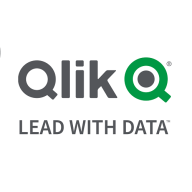

MicroStrategy and Qlik Sense both operate in the business intelligence and analytics domain, providing tools for data analysis and visualization. Based on features, Qlik Sense appears to have the upper hand due to its user-friendliness and powerful self-service capabilities.
Features: MicroStrategy is known for its scalable data processing, advanced SQL engine, and extensive mobile integration. It offers robust metadata management and supports a collaborative multi-user development environment. Qlik Sense stands out with its associative data model, in-memory engine, and intuitive drag-and-drop dashboards, which enable easy and quick data exploration.
Room for Improvement: MicroStrategy faces challenges with its complex licensing model, needs for improved visualization tools, and easier third-party integration. It also requires better support and simplified report creation. Qlik Sense could benefit from more robust data integration, enhanced customization options, and a review of its licensing model which currently often requires third-party extensions.
Ease of Deployment and Customer Service: Both MicroStrategy and Qlik Sense support deployment in cloud and on-premises environments. MicroStrategy's tech support receives mixed reviews, though its community forums are helpful. Qlik Sense offers an easy deployment process but requires improvement in support availability and response time. Both have customer service but face occasional issues with delay and complexity.
Pricing and ROI: MicroStrategy’s licenses are generally expensive for smaller businesses but are seen as a good long-term investment with potential for significant ROI. In contrast, Qlik Sense offers competitive pricing and flexible options, leading to a quicker ROI. Users suggest careful licensing assessment to manage costs.
In my organization, we moved from OBI to Qlik Sense due to limitations with OBI, resulting in very high ROI.
I would rate the technical support from MicroStrategy as nine out of 10.
While tech support is comprehensive, the stability of Qlik Sense means I generally do not need it.
I think they lack in the support system.
In Turkey, the consultant firms are very professional, and they support you.
It is easily scalable with Microsoft, with other services Azure and other tools they provide.
Qlik Sense helps analyze data and can handle larger amounts of data compared to other BI tools.
It performs well in terms of performance and load compared to others.
I would rate the stability of MicroStrategy as nine out of 10.
The stability is very good.
Organizations that are well-established and have more money can afford MicroStrategy, but startups and mid-level organizations who do not have this much budget have to opt for other cheaper tools.
MicroStrategy could learn from Power BI's user-friendly interface.
Power BI has better visualizations and interactions with updates in 2023 that provide ease of use.
Providing an API feature to access data from the dashboard or QEDs could be beneficial.
There should be more comprehensive documentation and explanatory videos available to help clients understand and calculate capacity-based pricing, making it easier to predict costs before implementing Qlik Sense Cloud.
It is just about how expensive it is to implement.
For small or large organizations needing many or few licenses, pricing varies.
Among the BI tools and data analytics tools, Qlik is the most expensive.
The MicroStrategy interface is not as good as Power BI, especially concerning the user-friendly aspects.
The most effective features of MicroStrategy for data analysis in my experience are the security, the metadata management, and the administration, along with the options of different workarounds available to accommodate different types of requirements.
From an end-user perspective, it's convenient and performance-oriented, providing something meaningful from all the organization's data.
The platform also includes AI/ML features for predictive modeling through a no-code component, allowing business users to create and deploy AutoML models without depending on data scientists.
It is a single product that I can use as an ETL database, BI, and more.
| Product | Market Share (%) |
|---|---|
| Qlik Sense | 12.2% |
| MicroStrategy | 11.0% |
| Other | 76.8% |


| Company Size | Count |
|---|---|
| Small Business | 37 |
| Midsize Enterprise | 26 |
| Large Enterprise | 99 |
| Company Size | Count |
|---|---|
| Small Business | 32 |
| Midsize Enterprise | 40 |
| Large Enterprise | 83 |
Company: Founded in 1989, MicroStrategy (Nasdaq: MSTR) is a leading worldwide provider of enterprise software platforms. With direct operations in 26 countries worldwide and approximately 2,000 employees, our mission is to provide enterprise analytics, mobility, and security platforms that are flexible, powerful, scalable and user-friendly. To learn more, visit MicroStrategy online, and follow us on Facebook and Twitter.
Product portfoilio:
MicroStrategy 10 Secure Enterprise™ empowers leading organizations to analyze vast amounts of data and distribute actionable business insight throughout an enterprise through two distinct offerings: MicroStrategy Analytics™ and MicroStrategy Desktop™. MicroStrategy Analytics delivers reports and dashboards, and enables users to conduct ad hoc analysis and share insights anywhere, anytime, via mobile devices or the Web. It also combines the agility and productivity of self-service visual data discovery with the security, scalability, and governance features of enterprise-grade business intelligence. MicroStrategy Desktop is a standalone, on-premise visual data discovery tool designed to enable business users to analyze and understand their data. MicroStrategy Mobile™ enables organizations to rapidly build custom business applications that deliver analytics combined with transactions, multimedia, and custom workflows to mobile devices. MicroStrategy Secure Cloud™ combines all of the enterprise analytics, mobile, and security features in MicroStrategy 10 Secure Enterprise with powerful and scalable data integration, validation, and warehousing services — all delivered in an environment where organizations can deploy transformational analytics applications in minutes.
Usher, MicroStrategy’s breakthrough security solution, is a powerful mobile security platform designed to dematerialize traditional forms of identity verification (such as passwords, tokens, and physical badges) and replace them with a single mobile identity badge that is cryptographically linked to its owner’s smartphone and dynamically linked to an enterprise’s existing identity repositories. Usher works on standard Android and iOS smartphones, and also boasts an Apple Watch™ integration.
Qlik Sense is a visual analytics and business intelligence (BI) platform that gives users full control over their system’s data. From this platform they can control every aspect of their system data. It maximizes an organization’s ability to make decisions driven by their data.
Benefits of Qlik Sense
Some of the benefits of using Qlik Sense include:
Reviews from Real Users
Qlik Sense stands out among its competitors for a number of reasons. Two major ones are its associative analytics technology and its remote access capability. Qlik Sense employs an associative analytics engine that gives users the ability to take their data analytics to the next level. Users can create visual connections between different datasets spread across their network, creating deep insights that enable users to gain a full understanding of their data. This engine is easily scaled up to allow a large number of users to benefit from the deep insights that it provides. Users can access Qlik Sense from anywhere in the world. Qlik Sense has an online portal that can be used consistently from anywhere at all. Having the ability to remotely analyze data gives users flexibility when it comes to choosing how to deploy their manpower.
Jarno L., the managing director of B2IT, writes, “The associative technology features are the solution's most valuable aspects. Qlik was the first company to implement an in-memory associative analytics engine. This basically means that all data is loaded into memory, but it also means that instead of joining data together, the data is associated together. From the front end, from the user interface point of view, data can be joined or included or excluded on the fly. It can be drilled down and drilled through and users can slice and dice it and that type of thing can be done from anywhere in the data to any other place in the data. It doesn't have to be predefined. It doesn't have to have hierarchies or anything like that.”
Tami S., the senior business intelligence analyst at the La Jolla Group, writes, “With the changing business landscape, it is nice to access Qlik Sense through an external website. As an organization when we use QlikView Desktop, we need to connect to our internal network. We can access QlikView through the QlikView access point but the website has a little different look and feel than the desktop application. We appreciate that Qlik Sense is browser-based and the user experience is the same whether at home, in the office or on a boat. As long as the user has internet access, performance is the same.”
We monitor all Embedded BI reviews to prevent fraudulent reviews and keep review quality high. We do not post reviews by company employees or direct competitors. We validate each review for authenticity via cross-reference with LinkedIn, and personal follow-up with the reviewer when necessary.